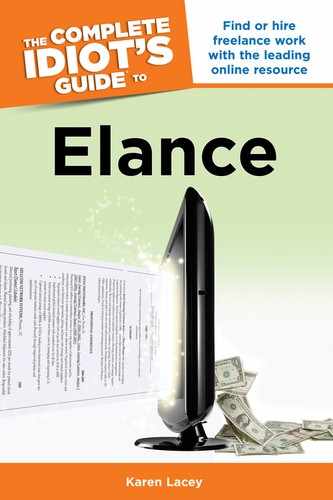Assessing the Proposals
Next comes reviewing and managing the actual proposals. This is one of the most critical steps. After your initial impression and rating, take a closer look at each proposal and revise your first opinion if appropriate.
| BEST PRACTICES |
One top client, Ken Lancaster, who’s posted over 400 projects on Elance, uses these three criteria for hiring successfully. One: High feedback ratings, 4.9 to 5 as averages. Two: Hire those freelancers that do this for a living, not as a side job. You can tell by the quantity of projects they do. Three: Look for high-quality work samples of the same type of work as you’re looking for.
Make a list of the most important qualities you’re looking for and see which contractors exhibited these. Much information can be gained from the proposal, so read each one carefully. This isn’t the only feature you’ll use to make your assessment, but it’s an important one.
Did They Listen?
Unfortunately, the cut-and-paste proposal beast is alive and well in the online work world. You will recognize these proposals immediately because they have nothing, or almost nothing, describing your distinct requests. Fortunately, you can spot these easily. Many top clients throw out all boilerplate proposals without a second glance.
Have a look at the following. This came in response to a detailed request for building a website:
“At the outset, thanks for taking the time to review our bid for this project. Take one look at our portfolio site and you’ll know why we should be ‘the’ choice for this assignment.
At our firm, we build brands, visual identities, and interactive web solutions that distinguish our clients from the crowd. With hundreds of clients in 21 countries, and over 12 years in the trenches—we’ve learned the art of keeping good company and staying ahead.
We are passionate about what we do, and would like to hear from you on how we can serve your needs. Come on in.”
Sounds good? But there’s not one detail that shows they read the project posting or assimilated and understood what was requested. This same response would work for thousands of jobs. Beware of this.
Questions Answered?
As you know from Chapter 11, one way to assess a contractor’s quality is to ask questions in your job posting. You can do this as a test to see if they respond, as many clients do, but also to genuinely see what they suggest for solving the issue at hand. If they don’t answer your questions, they aren’t paying attention.
Do They Understand?
Does the contractor have a clear grasp of what the job entails? If you want a series of articles written, does she understand the timeline, copy length, scope of material, and voice you’re asking for? Top contractors will let you know they understand in their proposals.
| CYBER SNAGS |
A red flag should go up when a contractor only wants to discuss the details of the project by phone or skype, not through workroom messaging. You don’t want to be in a position where they can say anything they want to close the deal, but you have no way to follow up and prove what they said. At the outset, communicate in such a way that you have a written record, preferably on Elance.
When a contractor asks you a question about the job, it’s a good sign. If they want something clarified, it means they’re listening. Watch for these and give them extra points.
